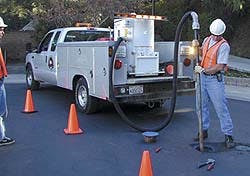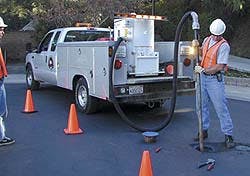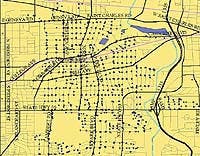A number of factors are increasing the work scope of today's water utilities: Construction is on the rise which requires additional time devoted to tie-ins; More regulations are being put in place (water quality testing, environmental controls, etc.); Customer Service demands continue to increase (there is an expectation of uninterrupted service, at all times); Water systems continue to age, more breaks are occurring, requiring immediate time and manpower be devoted to repair what is already in place. Water utility manpower levels are not growing.
The combination of these factors, in most cases, leads the utility to spend much of its time and energy working on time critical "emergencies" which leaves precious little time for ongoing maintenance (that can prevent such emergencies in the first place).
Wachs Utility Services was formed to execute ongoing water system maintenance so the utility can focus on time critical "emergency" work. The company offers valve-exercising programs, hydrant flushing programs, hydrant flow testing, leak detection programs, valve box vacuuming, and other preventative maintenance services.
Recently the company helped the Village of Riverside, IL, accomplish a number of objectives. Marty Keifer, Director of Public Works, was three years into his new job and decided that what he really needed was a valve-exercising program that would:
- Number the valves in the system
- Clean out the valve boxes
- Exercise the valves
- Identify problem valves
- Collect information on the valves (including GPS)
- Construct a map of the system
When he entered into the project Keifer was not sure how accurate his maps were, when many of the valves had been last turned and what percent of the system was really operable. Because it is an older system, he expected that around 30 percent of the valves might be inoperable.
Wachs Utility Services worked with Keifer to assemble a program that incorporated identifying, vacuuming out, inspecting, exercising and collecting data (including GPS positions) on all of the valves in the system.
In summary the program's tasks included:
- The valve exercising program
- Traffic control, to insure a safe area for the operators and citizens
- Assigning a ID number for each valve
- Inspecting each valve and valve box
- Cleaning out the valve box using a vacuum
- Exercising the valve, twice, using a minimal amount of torque
- Documenting valve ID number, street, cross street, house number, location (off of street centerlines), size, type, turns, torque, condition (inoperable, poor, fair, good), depth, size, and operating comments (such as packing leaks, broken operating nuts, etc.)
- Delivering a ValveCard database with all of the valve information loaded
- Delivering a map of the community, with the valves located on the streets
- Delivering a paper report, summarizing the system, its problems and all of the data collected
The scope of the program was 550 valves ranging from 4 inches to 16 inches. In addition to mainline valves, a number of hydrant isolation valves were exercised as well.
Wachs Utility Services used a fully fitted out service truck to execute the work. In this program, staff vacuumed water, mud and debris out of 66 valve boxes and vaults using an onboard Trav-L-Vac 300 Utility Vacuum System. This operation provided access to the valve for operation and inspection.
Wachs Trav-L-Vacs are capable of handling solid and liquid debris for applications such as valve box, vault and basin cleanout and also cleanup of sludge and industrial spills. Various models are capable of vacuuming water at 100 to 350 gpm, and lifting solids up to 90 lbs., with debris holding tanks as large as 900-gallon capacity.
After cleanout was completed, all the valves were inspected, location and valve information was collected and the valves were exercised.
The service crew exercised the valves using a Wachs Turn-N-Count (a handy manual ratcheting valve turner featuring an integrated revolution counter), a Wachs Pow-R-Drive portable powered handheld valve operator (perfect to reach hard to turn valves), or a Wachs TM-7DT Truck Mounted Valve Operator (which turns all valves from 6 inch to 60 inch and exercises even the most stubborn valves safely using its patented Automated exercising procedure which automatically controls the torque and turning direction).
The crew used a Trimble Pro-XRS GPS device and data logger to collect the GPS location and all of the specific operating information on each valve.
All of the exercising, operational, location and GPS information was transferred automatically to the ValveCard system for analysis.
Wachs' ValveCard 1.2 software is an interactive valve maintenance management program that stores and organizes valve data and allows operators to manage a valve distribution system from a desktop PC. The software provides for valve identification, valve data, location, special notes and information as well as the ability to construct and save valve and activity queries via a query builder. It works as a stand-alone tool or as a part of a fully integrated GIS system.
When using the Wachs truck-mounted TM-7-DT operator, the valve activity data (such as torque, turns, direction, condition, date and time) can be automatically transferred directly to the ValveCard database.
A specific valve card file was created for each valve in the system. The valve cards can be printed out in a number of formats.
By collecting the GPS location data on each valve, staff was able to create a map of the valves in the system, which can be used as a tool to manage the valve system. Each valve in the system is represented by a dot, and each valve card file for a specific valve (or area of valves) can be selected and displayed through this mapping feature.
ConclusionBy employing a Wachs Utility Services valve-exercising program, the utility was assured that its valves were accessible and exercised. Keifer was then able to focus on those valves that did not operate properly and knew the status of his system for future shutdowns and operations.Keifer was very happy with the program, its execution and the information he received about the system. He now has more confidence in the system and is able to concentrate on the problems and not worry about the whole system. He plans on having Wachs Utility Services back again next year to exercise hydrant isolation valves and flush hydrants. WW/






